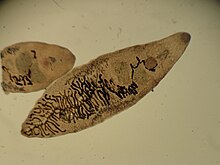
The order Cephalaspidea, also known as the headshield slugs and bubble snails, is a major taxon of sea slugs and bubble snails, marine gastropod mollusks within the larger clade Euopisthobranchia. Bubble shells is another common name for these families of marine gastropods, some of which have thin bubble-like shells. This clade contains more than 600 species.

Digenea is a class of trematodes in the Platyhelminthes phylum, consisting of parasitic flatworms with a syncytial tegument and, usually, two suckers, one ventral and one oral. Adults commonly live within the digestive tract, but occur throughout the organ systems of all classes of vertebrates. Once thought to be related to the Monogenea, it is now recognised that they are closest to the Aspidogastrea and that the Monogenea are more closely allied with the Cestoda. Around 6,000 species have been described to date.

Alcyonacea are an order of sessile colonial cnidarians that are found throughout the oceans of the world, especially in the deep sea, polar waters, tropics and subtropics. Whilst not in a strict taxonomic sense, Alcyonacea are commonly known as "soft corals" (Octocorallia) that are quite different from "true" corals (Scleractinia). The term “soft coral” generally applies to organisms in the two orders Pennatulacea and Alcyonacea with their polyps embedded within a fleshy mass of coenenchymal tissue. Consequently, the term “gorgonian coral” is commonly handed to multiple species in the order Alcyonacea that produce a mineralized skeletal axis composed of calcite and the proteinaceous material gorgonin only and corresponds to only one of several families within the formally accepted taxon Gorgoniidae (Scleractinia). These can be found in order Malacalcyonacea (taxonomic synonyms of include : Alcyoniina, Holaxonia, Protoalcyonaria, Scleraxonia, and Stolonifera. They are sessile colonial cnidarians that are found throughout the oceans of the world, especially in the deep sea, polar waters, tropics and subtropics. Common names for subsets of this order are sea fans and sea whips; others are similar to the sea pens of related order Pennatulacea. Individual tiny polyps form colonies that are normally erect, flattened, branching, and reminiscent of a fan. Others may be whiplike, bushy, or even encrusting. A colony can be several feet high and across, but only a few inches thick. They may be brightly coloured, often purple, red, or yellow. Photosynthetic gorgonians can be successfully kept in captive aquaria.

Plagiorchiida is a large order of trematodes, synonymous to Echinostomida. They belong to the Digenea, a large subclass of flukes. This order contains relatively few significant parasites of humans.

Echinostomata is a suborder of the parasitic flatworm order Plagiorchiida. The suborder contains numerous species that are parasitic in humans.

Acochlidiacea, common name acochlidians, are a taxonomic clade of very unusual sea snails and sea and freshwater slugs, aquatic gastropod mollusks within the large clade Heterobranchia. Acochlidia is a variant spelling.
Nitrospirota is a phylum of bacteria. It includes multiple genera, such as Nitrospira, the largest. The first member of this phylum, Nitrospira marina, was discovered in 1985. The second member, Nitrospira moscoviensis, was discovered in 1995.
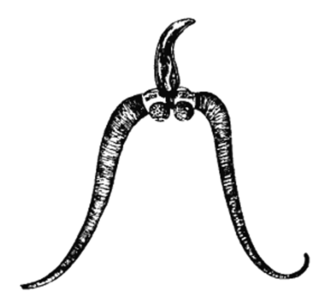
Bucephalus is the genus name for many trematode flatworms that are parasites of molluscs and fish. Like other Bucephalidae, they are found in fish both as adults and as metacercariae. In marine and freshwater teleosts, they live as parasites inside the digestive tract, especially the intestine.

Bucephalidae is a family of trematodes that parasitize fish. They lack suckers, having instead a muscular organ called a "rhynchus" at the front end which they use to attach to their hosts. The characteristics of the rhynchus are used to help define the genera of the family. It is one of the largest digenean families, with 25 genera containing hundreds of described species. Bucephalids are cosmopolitan, having been recorded all over the world. They are parasites of fish from freshwater, marine, and brackish water habitat types.

Opecoelidae is a family of trematodes. It is the largest digenean family with over 90 genera and nearly 900 species, almost solely found in marine and freshwater teleost fishes. It was considered by Bray et al. to belong in the superfamily Opecoeloidea Ozaki, 1925 or the Brachycladioidea Odhner, 1905.
Aegires albus is a species of sea slug, a nudibranch, a marine, opisthobranch gastropod mollusk in the family Aegiridae. Its synonym Anaegires protectus Odhner, 1934 is the type species of the genus Anaegires Odhner, 1934 which was merged with Aegires by Wägele in 1987.

Gastrocotylidae is a family of polyopisthocotylean monogeneans. All the species in this family are parasitic on fish.
Neohelicometra is a genus of trematodes in the family Opecoelidae. It consists of only one species, Neohelicometra scorpaenae.
Opecoeloides is a genus of trematodes in the family Opecoelidae. It has been synonymised with Cymbephallus Linton, 1934 and Fimbriatus von Wicklen, 1946.
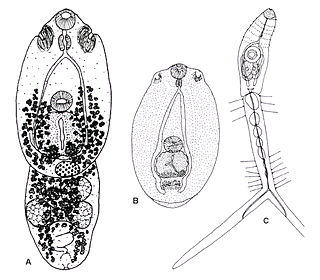
Diplostomida is an order of trematodes in the subclass Digenea. It is synonymous with Strigeatida Poche, 1926.

Echinostomatidae is a family of trematodes in the order Plagiorchiida, first described in 1899.
Himasthlidae is a family of trematodes in the order Plagiorchiida.
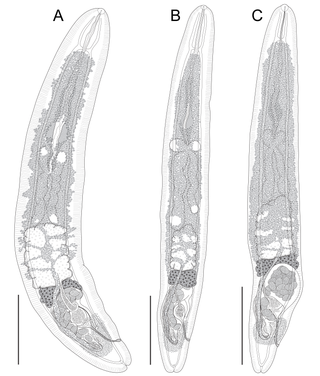
Aporocotylidae is a family of trematodes within the order Diplostomida, which contains species commonly known as fish blood flukes. It contains more than 40 genera, the largest being Cardicola. Species in this family parasite fish in both fresh and marine water.
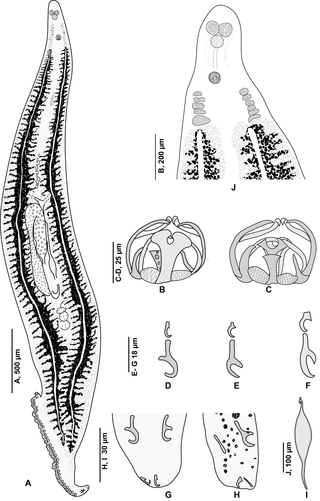
Pseudaxine is a genus which belongs to the phylum Platyhelminthes and class Monogenea; all its species are parasites of fish.

Nils Johan Teodor Odhner was a Swedish zoologist. Odhner was born in Lund, Sweden. He was the son of the historian and archivist Clas Theodor Odhner and the father of the agronomist Clas-Erik Odhner.
